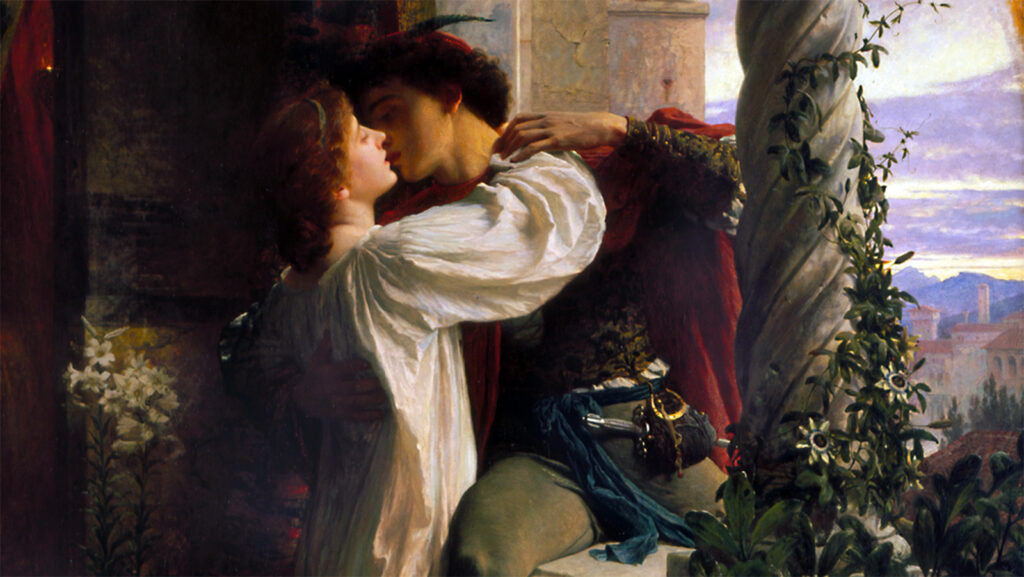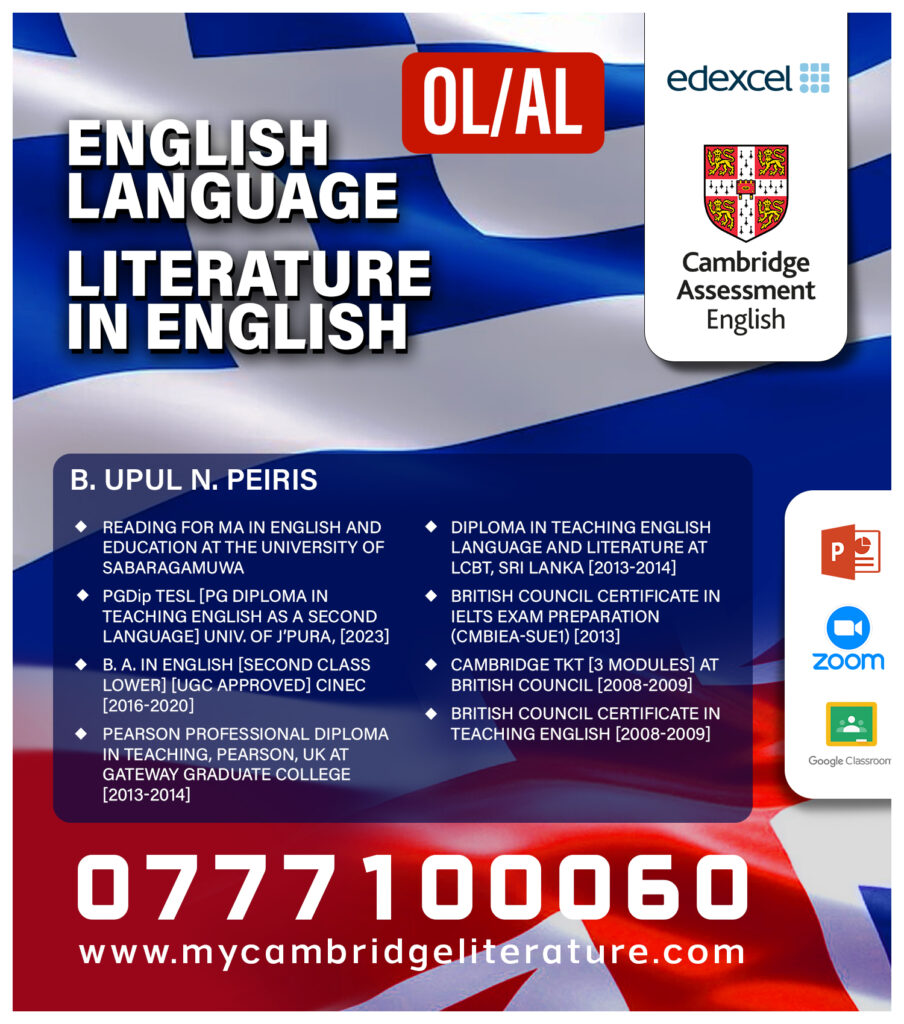BunPeiris’s Lecture Series, Part 2: Romeo and Juliet: love and conflict

The Interplay of Love and Conflict in Romeo and Juliet

Venue: Sir Charles Henry De Soysa Memorial Theatre, Moratuwa
bunPeiris [B. Upul N. Peiris] of Moratuwa.
Hi Cambrians, Sebastians, and Moratuwites! It’s me again. I am bunPeiris, nemo, but still one of yours, to the boot, to the hilt. Let’s kick things off with a question, then find ourselves either swimming or sinking in the sea of interpretations and arguments that follow from now on. This is going to be fun!
To set the stage: in The Tragedy of Romeo and Juliet by none other than the greatest dramatist of all time, William Shakespeare—the unrivaled master of the English language and the ultimate voice of the human condition. All others, even the brilliant Joseph Conrad, are simply skilled practitioners of English.
Now, let’s dive in!
Edexcel Examination-type Question 1: How does Shakespeare introduce the themes of love and conflict in Act 1, Scene 5 of Romeo and Juliet?
Well, I know you are now expecting a model answer as I have done in some written questions of Romeo and Juliet Q and A series 1 to 4 and still batting. But herein I am speaking to you face to face. Okey.
While we discuss, you may make notes of keywords and phrases. I will e-mail the video and audio recordings to you, guys.
I won’t simply give you a model answer to the question ‘How does Shakespeare introduce the themes of love and conflict in Act 1, Scene 5 of Romeo and Juliet?’ No, no, no.
“Okay, you guys and dolls, today we’re tackling the question: How does Shakespeare introduce the themes of love and conflict in Act 1, Scene 5 of Romeo and Juliet? Now, I’m not going to hand you a ready-made answer. No, no, no! Instead, I’m going to guide you through the process of building your own response. Ready?”
“Yes, sir!”
“Great! Let’s start by breaking down the question. What two key themes are we looking at here?”
“Love and conflict!”
“Exactly. Now, here’s something important to think about: Why do you think love and conflict are mentioned together so often in Romeo and Juliet? How are they connected?”
“Maybe because love and conflict happen at the same time in the play?”
“Yes, absolutely! Shakespeare intertwines love and conflict. But how? What’s happening in Act 1, Scene 5, that shows this?”
“That’s when Romeo meets Juliet and falls in love with her.”
“Right, Romeo sees Juliet for the first time and both of them fall in love with over head over heels a the first sight. What kind of language does he use to describe her?”
“He says she ‘teaches the torches to burn bright’ and calls her a ‘rich jewel.’”
“Oh! I love it. Romeo uses light and beauty to describe Juliet. This is our evidence of love. Shakespeare’s language is rich with imagery here. Now, is this the only thing happening in this scene?”
“No.”
“Good! What else is going on? What’s the conflict in this same scene?”
“Tybalt sees Romeo and gets angry because Romeo is a Montague.”
“Supershow! Tybalt is furious that a Montague has dared to come to the Capulet party. In his eyes, it was an act of disrespect, an insult. He calls for his sword, showing how deep the conflict between these families runs. So, we’ve got love at first sight, and we’ve got violent family conflict boiling up at the same time. But why does Shakespeare put these two together in the same scene?”
“To show that love and conflict can happen together?”
“Brilliant, Love and conflict are intertwined in Romeo and Juliet. Shakespeare is showing us that these powerful emotions can exist side by side, even in the very moment Romeo and Juliet fall in love. Tybalt’s anger is a constant threat to their love. Does anyone see how that connects to the rest of the play?”
“It shows that their love is always going to be in danger because of the conflict between their families.”
“Yes! Perfect. I love you guys immediately. Shakespeare uses this scene to foreshadow the trouble their love will face. Love and conflict aren’t just themes—they’re woven into every interaction, every moment of the play. And when you build your answer, use these pieces of evidence from the text to show how these themes are connected. Do you follow me?”
“Yes Sir.”
“ Again, let me explain. Shakespeare presents love and conflict as contrasting forces in Romeo and Juliet. The play explores the beauty and intensity of romantic love, while simultaneously highlighting the destructive power of family feuds and hatred. Romeo and Juliet’s love is tender, passionate, and pure, but it is born into a world full of violence and division. Their love cannot escape the harsh reality of the Capulet-Montague feud, creating tension between their desire for unity and the surrounding hostility. Oh! That’s too fast, isn’t it? Let’s break that into pieces.
[a] How do you support the claim Romeo and Juliet’s love is tender, passionate, and pure?
[b] How does the play explore the beauty and intensity of romantic love?”
Alright, let’s dive into an engaging discussion of two central questions regarding Romeo and Juliet, one of Shakespeare’s most famous tragedies. These questions will help us uncover the layers of love in the play and explore the beauty and intensity of romantic love as Shakespeare presents it.
[a] How do we support the claim that Romeo and Juliet’s love is tender, passionate, and pure?
The tenderness of Romeo and Juliet’s love is apparent from the very first moment they meet. They fall in love. Head over heels. At first sight. Shakespeare’s use of language plays a significant role here. Look at Act 1, Scene 5, where Romeo first encounters Juliet. Notice how he speaks to her with reverence and humility. He says, “If I profane with my unworthiest hand / This holy shrine, the gentle fine is this: / My lips, two blushing pilgrims, ready stand / To smooth that rough touch with a tender kiss.”
Man, do you want to talk love? Read the first verbal thrust and parry at the feast and monologue, result, and dialogue at the balcony. Here is the juiciest love talk ever. Learn to talk love.
[Audience erupts in laughter]
Now, come’n , do not misunderstand, not in school, goddamitman, In university. Get to university where the fun is.
Now, what do we see here? Romeo is not only complimenting Juliet but elevating her to the status of something sacred, something holy. Such is her beauty, innocence radiated in her face and demeanor, she seems an angel and saint at once. This metaphor, where he compares her to a saint and himself to a pilgrim, reflects a deep emotional connection beyond just physical attraction. [*1] Words like “holy” and “gentle” convey tenderness. Romeo’s feelings are respectful and admiring. They reflect a love that is soft, kind, and full of reverence.[*2] Do you see how tenderness here is not just about softness but also a kind of spiritual respect for Juliet?
Then, Romeo and Juliet’s passion is palpable throughout the play. Their immediate connection is so strong that the intensity of their emotions feels almost tangible to the audience. Sweeeeeeeeet Jesus! It’s a goosebumps situation, they are the only offsprings of rival clans that hold each other in utter hatred.
Think about the intensity of their first kiss. After they kiss, Juliet says, “You kiss by the book.” What’s she implying here?
Don’t we have nice Sinhalese slang idiomatic expression?
Yes, sir, we say “pothe hatieta.”.
Precisely, in Sinhala we say so: in line with the instructional manual.
Manual of Kissing
Oh!, yea, you have read that too. Oh! Boy, matters cannot get any better.
[The audience roars in laughter]
I am primed to the very toe.
[The audience roars in laughter]
Hey, I love you man, IMMEDIATELY!
[The audience roars in laughter]
Whatever you do, put your mind, heart, and soul into it. That’s passion, man, that’s passion. We must have passion.
Even more than the reason?
In love, yes, that’s how you love. Love sans reason, love sans borders, love sans all. You are the one!
Well, you kiss when you love. And love has no restraints. Love is blind. Love conquers all.
There’s a sense of surprise and wonder in thirteen-year-old Juliet’s words, as if she wasn’t expecting the kiss to be so full of passion, emotion, and intensity.
Romeo, on his part, is deeply committed to their love. In Act 2, Scene 2, he boldly declares, “With love’s light wings did I o’er-perch these walls; / For stony limits cannot hold love out.” This imagery speaks volumes. Romeo sees love as something so powerful that it can transcend any physical or social barriers, including the feud between their families. The walls around the mansion house of Juliet are no hurdle too high and long for our fourteen-year old lover boy. We too have a historical episode of a prince by the name Deegagamani who scaled a tall tower having a single chamber on the top, don’t we?
Yes, sir, Unmada Chithra and Deegagamani
Oh! Yea, Deegamni held, swirled, and hurled a rope ladder to the chamber at the top, Unmada Chithra, the maddening beauty, wouldn’t drop it. She caught it, well-held princess!
You know, talking about wings and hurdles sends me reeling back to my school days at Prince of Wales’ College, Once during a Colombo district sports meet, the 400-meter hurdles was about to kick off. One of our classmates said, “Gamini Wickramanayake will fly over the hurdles like a bird on a wing. This is no competition for him.” I liked my classmate’s metaphor: Gamani was so fast. So was his sister, Jean at Princess of Wales’ College, Moratuwa.
Here, Shakespeare tells us that their love is more than just a fleeting emotion. It’s passionate, yes, but it also has a kind of invincibility about it. This passion is not reckless; it’s powerful and enduring.
Then finally, purity. Despite the violent feud between their families, the love Romeo and Juliet share remains pure. Think of Juliet’s reaction when she discovers that Romeo is a Montague. In Act 1, Scene 5, she exclaims, “My only love sprung from my only hate!” This line perfectly captures the essence of their pure love—it emerges despite the hate that surrounds them. In “fair Verona” where two noble houses boil in hatred, they found love.
What’s important here is the context of their relationship. From the moment they meet, their love is genuine, untainted by the political or familial strife around them. Juliet’s focus on marriage in Act 2, Scene 2—“If thy love be honorable, / Thy purpose marriage, send me word tomorrow”—shows her desire for a committed, sacred bond. This isn’t just a fleeting infatuation; it’s a love rooted in integrity, honor, and purity.
They planned to get married the following day.
They didn’t do room.
[Audience roars in laughter]
Do you know how many rooms are rented for a couple of daytime hours in our fair Sri Lanka?
Statistics are available. Seek, locate, and make your own deductions.
Romeo and Juliet thought, sought, and secured marriage at church.
Romeo, too, expresses the purity of his love when he says, at the tragic end of the drama, “Then I defy you, stars!” This line signifies that, even in the face of fate, their love remains inviolable and true. Even in death, they seek unity. Their love transcends life itself, which underscores its purity.
I woke up with a shudder. Four tall white walls surrounded me. I realized I was only dreaming.
[b] How does the play explore the beauty and intensity of romantic love, particularly in Act 1, Scene 5?
To be continued.

